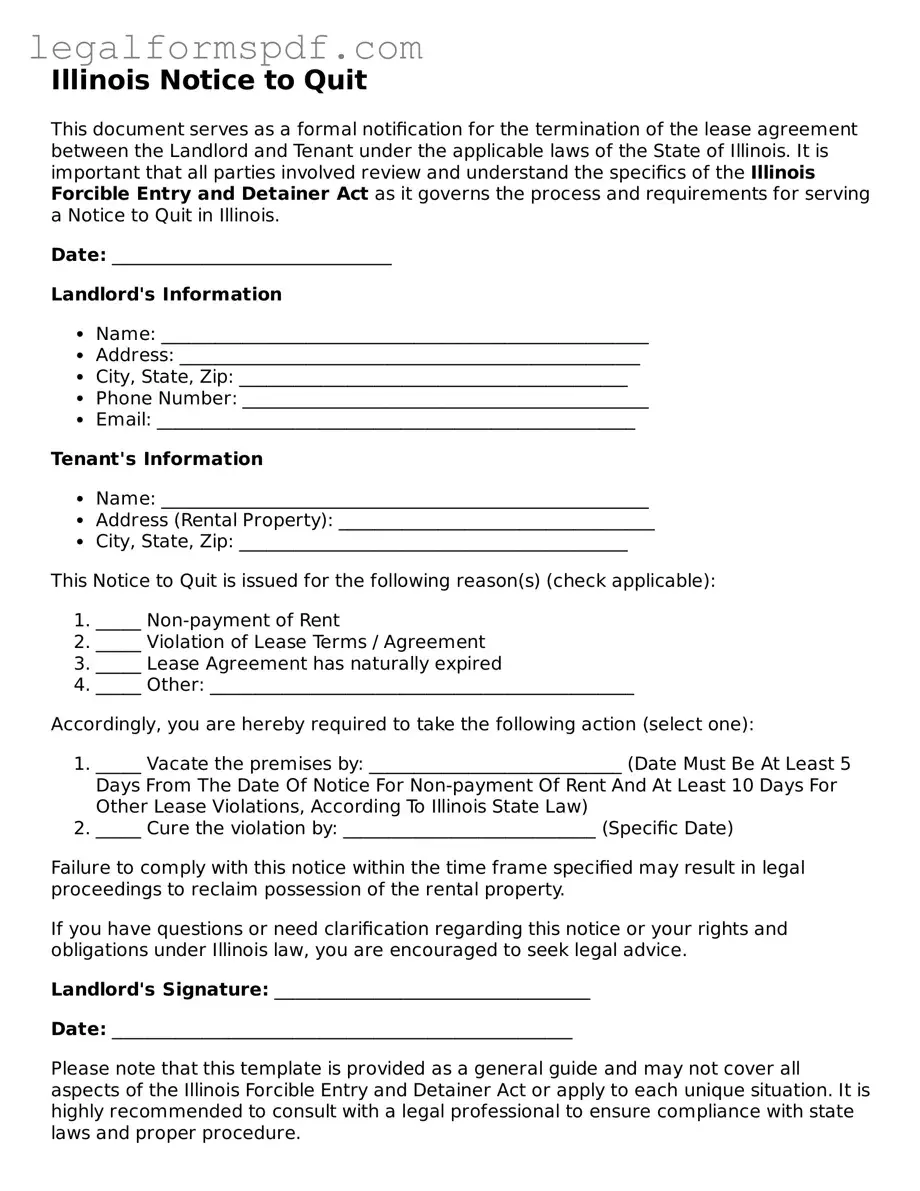Sure! Here's a formatted FAQ section regarding the Illinois Notice to Quit form.
What is an Illinois Notice to Quit form?
An Illinois Notice to Quit is a legal document that a landlord sends to a tenant to notify them of a lease violation or the termination of their tenancy. This form is an essential step in the eviction process if a tenant has failed to comply with the terms of their lease agreement.
When should a landlord use an Illinois Notice to Quit?
A landlord should use an Illinois Notice to Quit when a tenant has violated terms of the lease agreement, such as failing to pay rent, damaging property, or engaging in illegal activities on the premises. It serves as a formal request for the tenant to either rectify the situation or vacate the property.
Is there a specific time frame to deliver an Illinois Notice to Quit?
Yes, the time frame to deliver an Illinois Notice to Quit depends on the reason for eviction. For non-payment of rent, landlords must provide a 5-day notice. For lease violations, a 10-day notice is required. It's important to note that these time frames are the minimum required by law, and landlords must adhere to them before proceeding with an eviction.
How is an Illinois Notice to Quit delivered to the tenant?
There are several methods to deliver an Illinois Notice to Quit, including personal delivery to the tenant, leaving a copy with someone of a suitable age and discretion at the premises, or mailing the notice via certified or registered mail to ensure receipt.
What information must be included in an Illinois Notice to Quit?
An Illinois Notice to Quit must include the tenant's name, the property address, a detailed explanation of the lease violation or the reason for termination, and the date by which the tenant must either correct the violation or leave the property. Additionally, the notice should have the landlord's signature and the date of issuance.
What happens if a tenant does not comply with an Illinois Notice to Quit?
If a tenant fails to comply with an Illinois Notice to Quit, the landlord can proceed with filing an eviction lawsuit in court. This legal action, known as a forcible entry and detainer suit, seeks to obtain a court order to remove the tenant from the property.
Can a tenant dispute an Illinois Notice to Quit?
Yes, a tenant can dispute an Illinois Notice to Quit by responding to the eviction lawsuit in court. Tenants may present their case, including any defenses as to why the eviction should not proceed. This might include proving the lease violation did not occur or that they have rectified the cited issue within the notice period.
Are there any exceptions to issuing an Illinois Notice to Quit?
Certain protections may prevent the issuing of an Illinois Notice to Quit, such as tenant rights under active military service or specific local ordinances that offer greater protection than state law. Landlords should ensure they are not violating any such protections when issuing a Notice to Quit.
What is the role of the court in the eviction process after an Illinois Notice to Quit is issued?
After an Illinois Notice to Quit is issued, the court's role is to ensure the legal process is followed correctly. This includes reviewing the Notice to Quit, any tenant defenses, and deciding whether an eviction is justified. If the court rules in favor of the landlord, it will issue an eviction order.
How can both landlords and tenants learn more about the Illinois Notice to Quit and eviction process?
Landlords and tenants can learn more about the Illinois Notice to Quit and the eviction process by consulting with a licensed attorney who specializes in landlord-tenant law or by visiting official state or local government websites dedicated to housing and rental regulations.
This section provides a comprehensive overview of the Illinois Notice to Quit form and its implications for both landlords and tenants, structured in a way that's easy to navigate and understand.
